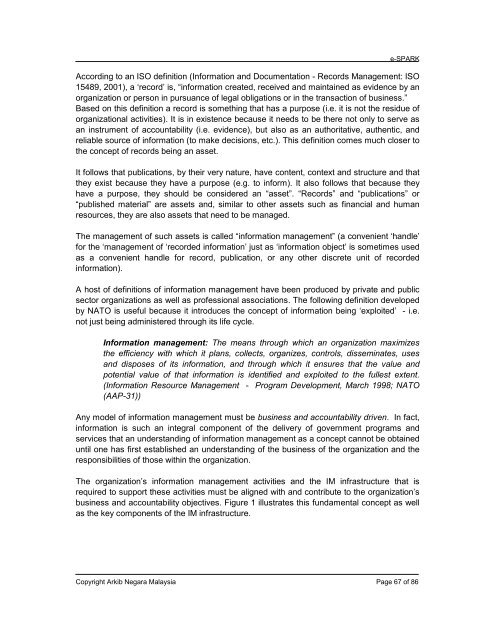Arkib Negara ELECTRONIC RECORDS MANAGEMENT and archive mgmt guideline_eng
Create successful ePaper yourself
Turn your PDF publications into a flip-book with our unique Google optimized e-Paper software.
e-SPARK<br />
According to an ISO definition (Information <strong>and</strong> Documentation - Records Management: ISO<br />
15489, 2001), a ‘record’ is, “information created, received <strong>and</strong> maintained as evidence by an<br />
organization or person in pursuance of legal obligations or in the transaction of business.”<br />
Based on this definition a record is something that has a purpose (i.e. it is not the residue of<br />
organizational activities). It is in existence because it needs to be there not only to serve as<br />
an instrument of accountability (i.e. evidence), but also as an authoritative, authentic, <strong>and</strong><br />
reliable source of information (to make decisions, etc.). This definition comes much closer to<br />
the concept of records being an asset.<br />
It follows that publications, by their very nature, have content, context <strong>and</strong> structure <strong>and</strong> that<br />
they exist because they have a purpose (e.g. to inform). It also follows that because they<br />
have a purpose, they should be considered an “asset”. “Records” <strong>and</strong> “publications” or<br />
“published material” are assets <strong>and</strong>, similar to other assets such as financial <strong>and</strong> human<br />
resources, they are also assets that need to be managed.<br />
The management of such assets is called “information management” (a convenient ‘h<strong>and</strong>le’<br />
for the ‘management of ‘recorded information’ just as ‘information object’ is sometimes used<br />
as a convenient h<strong>and</strong>le for record, publication, or any other discrete unit of recorded<br />
information).<br />
A host of definitions of information management have been produced by private <strong>and</strong> public<br />
sector organizations as well as professional associations. The following definition developed<br />
by NATO is useful because it introduces the concept of information being ‘exploited’ - i.e.<br />
not just being administered through its life cycle.<br />
Information management: The means through which an organization maximizes<br />
the efficiency with which it plans, collects, organizes, controls, disseminates, uses<br />
<strong>and</strong> disposes of its information, <strong>and</strong> through which it ensures that the value <strong>and</strong><br />
potential value of that information is identified <strong>and</strong> exploited to the fullest extent.<br />
(Information Resource Management - Program Development, March 1998; NATO<br />
(AAP-31))<br />
Any model of information management must be business <strong>and</strong> accountability driven. In fact,<br />
information is such an integral component of the delivery of government programs <strong>and</strong><br />
services that an underst<strong>and</strong>ing of information management as a concept cannot be obtained<br />
until one has first established an underst<strong>and</strong>ing of the business of the organization <strong>and</strong> the<br />
responsibilities of those within the organization.<br />
The organization’s information management activities <strong>and</strong> the IM infrastructure that is<br />
required to support these activities must be aligned with <strong>and</strong> contribute to the organization’s<br />
business <strong>and</strong> accountability objectives. Figure 1 illustrates this fundamental concept as well<br />
as the key components of the IM infrastructure.<br />
Copyright <strong>Arkib</strong> <strong>Negara</strong> Malaysia Page 67 of 86


